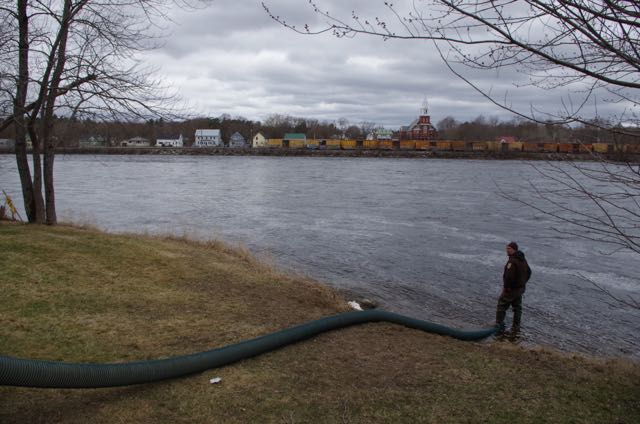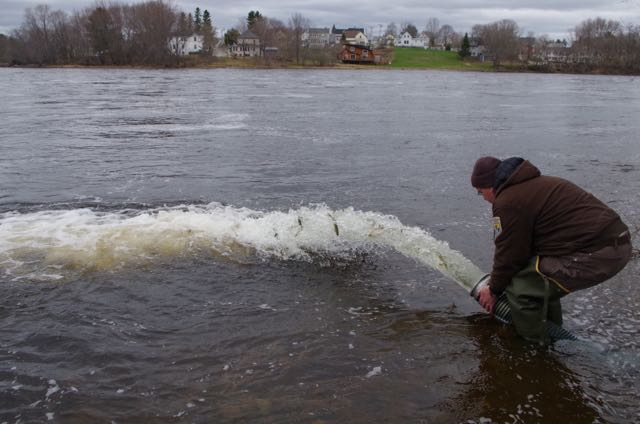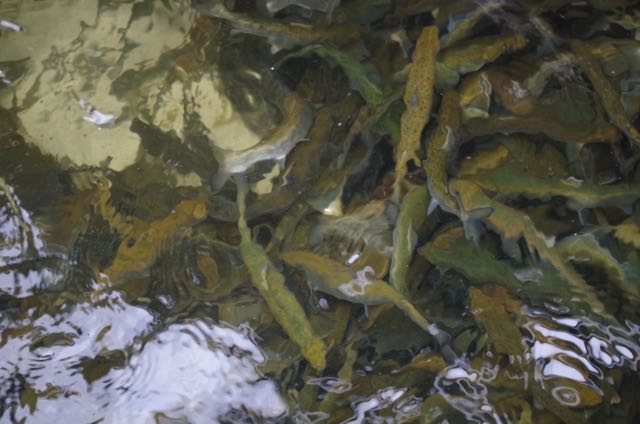Salmon Delivery
April 30, 2015 | Green Lake National Fish Hatchery

After an epic winter, spring has arrived in the Penobscot River Valley. Ice is out on the lower river and most of the tributaries, and the water temperature has reached a still-chilly 5 degrees Celsius. Fred Trasko and the rest of the U.S. Fish and Wildlife crew are preparing to transfer 24,000 smolts to the river for their seaward migration thousands of miles to the sub-Arctic waters around Greenland.
The smolts came from Penobscot River adult salmon spawned at Craig Brook National Fish Hatchery in Fall 2013. The pea-sized, orange eggs incubated at Craig Brook through last winter, and were brought to the much larger Green Lake hatchery in early spring 2014. Fed larger and larger food, they grew to a length of six to nine inches over the course of the year. In the wild, salmon reach the smolt stage after two years. The hatchery fish are accelerated to save space and money – raising, feeding, and caring for half a million fish for one year is hard enough.
Fish are loaded into three trucks with aerated tanks. The caravan rumbles from Ellsworth to Milford via Routes 1, 46, 9, and 178, through still-bare forests and over thawing swamps. The trees are just beginning to bud.

The trucks make a final turn down a residential street that ends at a grassy bank of the river. Cormorants, mergansers, and seagulls hover nearby. The river rushes high and dark–rapids now that the Great Works dam has been removed–converging below the southern tip of French Island. Across the river, rusty, graffitied freight cars sit on the tracks by the Old Town mill.
A hose attaches to the bottom of the tank, Trasko opens the chute, and gravity does the rest. Thousands of smolts gush into the river. Some take off right away, others stay nearby, resting in the current, facing upstream. Eventually, they will turn around and head toward the sea. More gulls have arrived, they dive and dine. As hard as it is to watch the birds snatching up the precious smolts, each of which cost about $1.25 to produce, Trasko and the others know its just part of the natural cycle; the high number of smolts is a hedge against loss: 175,000 thousands smolts have been released since Monday.

In all, 355,000 smolts will go into the river this year, fewer than usual because of reduced hatchery operations during the government shutdown in Fall 2013. With fewer smolts and even fewer adults returning in recent years, hatchery fish are being released below Milford, now the first/last dam on the river (thanks to the Penobscot River Restoration Project), so they have a greater chance of surviving the journey.
Three to five weeks in the river will be enough for the smolts to “imprint” on their home waters, then they will travel to the bay. They will be joined by their wild siblings and cousins, as well as smolts that came from hatchery eggs but were placed in the river as tinier juveniles. (See a post from last spring about sampling these river smolts.)
If everything goes according to plan, an estimated 600 of these smolts will (hopefully) return as adults in a year, or two, or three.
